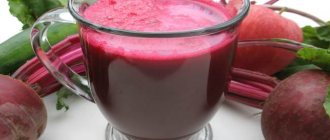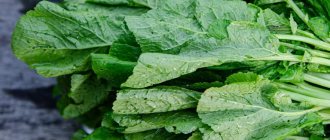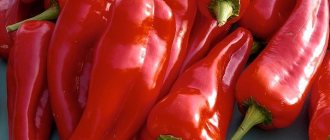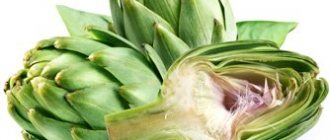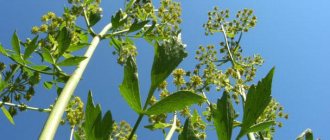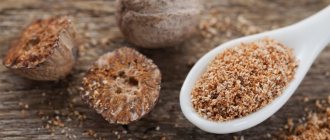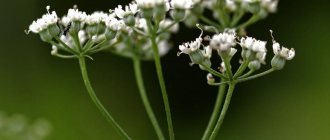Benefits to the body
Thanks to its valuable natural components, Japanese radish helps keep the heart, lungs, kidneys and liver healthy. The benefits of daikon have been noted for diseases of the digestive and nervous systems, and bone tissue. In addition, this root vegetable can lift your mood, increase performance, and reduce the likelihood of developing cancer.
Digestive system
One of the Japanese nutrition institutes conducted research on daikon and its effect on the body. It was reliably established that the vegetable contains enzymes similar in composition and properties to the important digestive enzymes amylase and esterase. These enzymes are involved in the breakdown of complex carbohydrates, fats and proteins. After preliminary preparation, these substances are easily absorbed by the body; complete absorption of nutrients supplied with food occurs in the intestines.
In addition, Japanese radish contains a lot of coarse insoluble dietary fiber, which helps cleanse the intestines of bacterial waste products, stagnant food, areas of fermentation and rotting. Daikon in the daily diet helps to improve the process of bowel movements, get rid of chronic constipation, gas formation and bloating.
Respiratory system
Most often, Japanese radish is used as an effective medicine for influenza, colds and respiratory tract infections. Protease, which is contained in the root vegetable, helps thin mucus. Thick, viscous sputum is the main cause of a dry, debilitating cough. Fresh daikon juice in its pure form or with the addition of honey helps in the treatment of tracheitis, bronchitis, and pneumonia.
The immune system
The root vegetable contains about 50% of the daily requirement of vitamin C, but its concentration in the leaves is even higher - up to 150%. Regular consumption of salads with daikon leaves and vegetable dishes with its root helps strengthen the immune system. Eating daikon is useful not only for prevention, but also directly during illness, since vitamin C stimulates the production of leukocytes, and therefore increases the chances of a speedy recovery.
Kidneys and liver
Daikon is one of the few vegetables that can help with urolithiasis and cholelithiasis. The substances included in its composition literally dissolve stones and promote their removal. The root vegetable effectively cleanses the kidneys and liver and has diuretic and choleretic properties. The root contains sulfur, which promotes the secretion of bile, which reduces the load on the liver and helps it cope with fatty foods. Potassium salts are responsible for the diuretic effect, removing excess fluid, toxins and harmful substances.
Natural antibiotic
Important beneficial properties of daikon include bactericidal and anti-inflammatory effects. Japanese radish contains lysozyme, a natural antibiotic, as well as phytoncides that help cope with inflammation in various organs and tissues. This vegetable can help with the following diseases:
- arthritis and gout;
- inflammation due to injuries and sprains;
- infections and inflammation of the respiratory tract;
- caries, inflammatory processes in the oral cavity;
- disorders, intestinal infections;
- vasculitis.
What are the beneficial properties of daikon?
- Cleansing the body. The vegetable is effectively used as a natural diuretic and laxative. The calcium and potassium salts contained in radish reliably cope with removing slagging and excess fluid from the body. Thanks to these qualities, daikon is the basis of proper and dietary nutrition, as well as cleansing diets.
- Strengthening the immune system. The fortified composition of the vegetable strengthens the body's immune forces, and protein components and phytoncides help cleanse the internal organs of microbes. Regular inclusion of daikon in the menu is a wonderful prevention of colds. The vegetable helps speed up and ease the course of diseases such as bronchitis, asthma, and various types of cough.
- Cleansing the kidneys and liver. Daikon is a natural cleanser of internal organs. The advantage of the vegetable is its pleasant taste, therefore, drinking a glass of daikon juice daily can improve the functioning of the pancreas, kidneys and liver, and also help remove stones.
- Improving the functioning of the nervous system. Since ancient times, radish has been used as a soothing product. People who suffered from nervous excitability or increased aggression were sure to drink half a glass of radish juice daily, thereby normalizing the functioning of the nervous system, gaining peace of mind and a wonderful mood. What are the benefits of daikon? Radish juice drunk before bedtime promotes full and healthy sleep.
- Prevention and treatment of diabetes. The beneficial properties of daikon radish help diabetics normalize blood sugar levels. The vegetable contains fructose, which is indispensable in the diet of patients with diabetes.
- Help in losing weight. The vegetable is a low-calorie product; the calorie content of daikon is only 18 kilocalories per 100 grams. fresh product. Radish helps cleanse the body of harmful components and get rid of toxins, so it can be safely included as a dietary product in the menu of people who want to lose weight harmlessly.
- Treatment of heart and blood vessel diseases. The beneficial qualities of the vegetable help prevent diseases such as atherosclerosis, high levels of cholesterol in the blood, and various diseases of the cardiovascular system.
- Treatment of skin ailments. Daikon radish is widely in demand in cosmetology. Using freshly squeezed juice, you can get rid of age spots and freckles, as it has whitening properties. In the treatment of acne and boils, daikon occupies a special place. It is believed that regularly rubbing radish juice into the skin helps to permanently eliminate skin inflammation and blemishes.
- Healthy hair. The fortified composition of the vegetable has a beneficial effect on the internal and external structure of hair. Radish juice rubbed into hair roots is an excellent strengthening and nourishing agent.
The benefits and harms of daikon lie in its composition. In what form can you consume this healthy vegetable? Daikon can be consumed in any form, it all depends on the preferences and wishes of the consumer. Radish can be stewed, fried, steamed, pickled or boiled. In some countries, they prefer to eat the vegetable only raw, while in other countries, daikon is used as an additional ingredient in soups, main courses and salads.
Of course, a fresh product that has not been subjected to any heat treatment is more useful. But fresh radish must be eaten immediately after preparation, since as a result of storage, most of the beneficial substances from daikon “evaporate.”
Methods of application
In Japan and China, daikon has been eaten for thousands of years. There it is included in the daily menu. In the East there are many ways to use the fruit. In Japan, radishes are served with sushi, stewed with seafood, salted for the winter and dried. In addition, miso soup is boiled and seasoned. In China, pies are baked from the vegetable, and in Korea, kamchi is prepared. In addition to the fruit itself, the tops and shoots are eaten.
In folk medicine
The eastern root vegetable is widely used by healers.
Healing properties are used by healers for various purposes:
Daikon leaves and juice are a good remedy for constipation. To prepare the infusion, take 1 tbsp. spoon of tops and pour a glass of boiling water. Leave covered for 40 minutes. Take cooled and strained 3 times a day 20 minutes after meals for 2-3 days. To treat purulent wounds, lotions made from pulp are used. To do this, the fruit is grated and applied, secured with a bandage. After a few hours, the bandage is replaced. Daikon is used as a remedy for arrhythmia. In this case, juice obtained from candied radish pieces is used. Take 1 tbsp. l. three times a day
Attention! Before using the traditional method, consult your doctor. Daikon stimulates cardiac activity.
The antibacterial and antiviral properties of Japanese radish allow it to be used as a remedy for colds.
In this case, the vegetable is consumed in the form of a salad or freshly squeezed juice mixed with honey.
For anemia, prepare a mixture of grated carrots, beets and daikon. The mass is mixed and baked in the oven. Take 1 tbsp for 2 months. l. three times a day before meals.
In cosmetology
The useful root vegetable is used for cosmetic purposes. Antifungal and antibacterial properties are used for diseases of the skin, hair and nails. The vegetable can get rid of freckles and age spots.
For acne and acne, masks are made from pulp. To do this, add sour cream or aloe to the grated radish, depending on your skin type. The mask is applied for 20 minutes, after which it is washed off with warm water. The vegetable is used to wipe the juice on the face. The procedure rejuvenates, reduces wrinkles, tightens contours.
Japanese daikon radish - composition, calorie content
The translation of the name of the vegetable means large root. The fruit is also known as sweet or Chinese radish.
Compared to its usual Russian relative, the eastern root vegetable is much larger. The weight of the vegetable varies from 2 to 5 kg. Some specimens reach 20 kg. The shape of daikon can be round, elliptical, cylindrical, but the most common is in the shape of a carrot.
The fruit attracts the attention of nutritionists with its balanced biochemical composition:
- cellulose;
- vitamins PP, group B, ascorbic acid, selenium;
- antioxidants;
- pectins;
- phytoncides;
- microelements - potassium, magnesium, phosphorus, selenium and iron;
- enzymes.
The calorie content of daikon is low - 21 kcal per 100 g of product.
This quantity contains:
- 1.2 g protein;
- 4.1 g carbohydrates;
- no fats.
Important! The combination of useful components allows nutritionists to include the vegetable in the daily menu for weight loss and cholesterol reduction.
What can be prepared from daikon: recipes
There is a fairly wide range of dishes that contain daikon. Juicy fruits can be stewed, pickled, and added to soups and salads. Before preparing the dish, the vegetable must be washed and the edges removed from both sides.
Then the root vegetable is peeled, and it is important to cut it off at the very top, removing a small layer, since the peel contains many useful substances
Daikon can also be used as table decoration. Despite the fact that daikon is consumed in different forms, the greatest benefits can be obtained from the raw product. For example, an excellent appetizer will come from a root vegetable chopped on a coarse grater with the addition of lemon juice and herbs.
You can also make a variety of salads from this vegetable. Cabbage, cucumbers, carrots, olives, and tomatoes go well with daikon. It can be included in cottage cheese and cheese dishes, and can also be used with meats such as beef and corn. Vegetables are also great for desserts. They can be mixed with fruits, nuts and honey. It should be borne in mind that dishes with sliced daikon fruits must be eaten almost immediately, since their taste is quickly lost.
Chicken and daikon salad
Ingredients:
- chicken breast – 1 pc.;
- daikon – 1 pc.;
- tomatoes – 3 pcs.;
- onion (red) – 1 pc.;
- garlic – 2 teeth;
- cucumbers – 1 pc.;
- lemon – 0.5 pcs.;
- yogurt (natural) – 250 g;
- dill.
How to cook:
- Place chicken breast in boiling water over low heat. Cover with a lid and cook for 50–60 minutes. It is better not to remove the skin or bone from the breast, as this will make the meat more tender.
- Peel the daikon and grate it (like a Korean carrot) or cut it into strips. Cut the tomatoes into cubes.
- Prepare salad dressing. Grind the cucumber on a coarse grater, add finely chopped garlic, yogurt, dill and squeeze out lemon juice.
- After the chicken meat has cooled, disassemble it into fibers.
- Mix vegetables with meat, add dressing.
Pickled carrots with daikon
Ingredients:
- water – 1 tbsp.;
- vinegar - 0.25 tbsp.;
- sugar – 2 tbsp;
- salt – 2 tsp;
- carrots – 250 g;
- daikon – 250 g.
How to cook:
- Cut carrots and daikon into thin strips.
- Put the water to boil, heat until warm.
- Add vinegar, salt and sugar to water.
- Stir until the sugar is completely dissolved.
- Place carrots and daikon in prepared jars.
- Pour the marinade into the jars, close them tightly and let it brew.
Video:
recipe for losing weight: Japanese daikon
httpv://www.youtube.com/watch?v=embed/NyyhIP8apNc
Daikon in cooking
The popularity of daikon in world cooking is growing every day - it is salted, pickled, crumbled into salads, combined with lean meat, vegetables, cheese and even fruits. Experienced chefs assure that the taste in the root of daikon is distributed in a very original way: all the bitterness is closer to the top, the subtlest shade is in the upper part, and the middle is the sweetest. So you can use different parts of the Asian radish for different dishes - and even an ordinary recipe will sparkle with new colors.
The delicate taste of daikon is reminiscent of radishes with a pleasant bitterness, so the most aromatic and healthy Japanese radish is fresh. But there is a little secret: after cutting, the root vegetable loses the lion's share of its beneficial properties within 30-40 minutes. This is why any daikon salad is so delicious - the recipes are designed so that it is simply impossible to leave them “for later”.
Spring salad with daikon and sesame:
You will need: 250-300 grams of daikon, 2 table. spoons of white sesame seeds, a small bunch of dill and green onions, table. a spoonful of chopped parsley, 2 small cucumbers, salt, pepper to taste, olive oil and soy sauce in a 3:1 ratio.
Grate the daikon on a coarse grater or cut into thin slices. Tear the dill coarsely, chop the onion, cut the cucumbers into slices. Mix with radish. Place the vegetables in a salad bowl, sprinkle with sesame seeds, pour over oil and sauce, salt and pepper.
Vegetable salad from daikon with chicken:
You will need: 200 grams of daikon, 150 grams of boiled chicken, 2 small tomatoes and cucumbers, greens - cilantro, basil, mint, for dressing - 4 tablespoons. spoons of unsweetened yogurt.
Divide the chicken fillet into fibers, peel the daikon and cucumbers, cut into thin strips, and cut the tomato into thin slices. Finely chop the greens, mix all the ingredients, season with yogurt and add salt.
The use of daikon in folk medicine
The vegetable is used in medicine to treat many diseases, as well as generally strengthen the immune system:
- Treatment of wounds, scratches, cracks and other skin damage. To do this, the root vegetable should be grated and applied to problem areas.
- Anti-cold use. To remove sputum, 50 grams of root juice are mixed with honey and drunk.
- To treat arrhythmia, the vegetable is grated and covered with granulated sugar. Then the resulting juice should be drunk before meals, 1 tablespoon 3 times a day.
- Canned daikon can help with anemia. It is necessary to grate the radish, carrots and beets, mix and place in the oven for 3 hours. Take 1 tablespoon 3 times a day.
- Patients suffering from radiculitis and rheumatism will benefit from a mixture of daikon, honey and water in a ratio of 3:2:1.
White radish for cough
A recipe of white radish with honey helps patients get rid of cough. Every housewife should have it. This mixture can be taken by both adults and children.
Rules for preparing the product:
- the top of the root crop is cut off;
- the core is scraped out;
- the space is filled with honey;
- after 12 hours, the root vegetable begins to release juice, which is mixed with honey.
After this, the resulting mixture can be drunk.
But there are other options for how to cook daikon. For example, finely chop a peeled vegetable into cubes, place in a container and add 3 tablespoons of honey. Close the lid and leave for 12 hours. Afterwards you can drink the resulting juice.
The duration of treatment is 10 days. Children should drink a teaspoon 2 times a day before meals. And adults take a tablespoon in the same way.
How to choose daikon
When choosing daikon, you should pay attention to the integrity of its skin and how shiny it is. Also, based on my own experience of storing and growing this plant, I will say that when choosing this vegetable, you should pay attention to its turgor. If, when you press on the daikon, you feel it sluggish and soft, then instead of juicy pulp, you risk getting tasteless, fibrous chewing gum in your salad. If possible, cut the fruit. When cut, the pulp should be uniform and moist throughout the entire depth of the cut.
The benefits of daikon for various diseases and conditions
The beneficial properties of Japanese radish are due to its rich chemical composition, but you should not abuse it, since only moderate consumption is good for health. Unlike many natural medicines, the vegetable does not need to be specially prepared in order to get the maximum benefit from it. Quite the contrary, only in its fresh form is it especially effective.
It is enough to consume a fresh salad in combination with other ingredients or freshly squeezed juice to nourish the cells with all the active substances.
For digestive disorders and hangovers
Indigestion is often a consequence of overloading with heavy or fatty foods.
In this condition, it is important to protect the liver from the stress that will be placed on it. The pectin and enzymes in daikon help digest food and prevent it from rotting, which would worsen the condition even further.
Drinking alcohol leads to poisoning of the body, and many, unfortunately, treat a hangover as a logical, but not serious, ailment.
This is incorrect, since poisoning of the body disrupts the functioning of all systems and the condition, which is popularly called a hangover, requires treatment. Daikon juice will help cope with dehydration - a companion to the disease, saturate cells with vitamins and minerals, regulate the acid-base balance and help remove toxins from the blood.
For metabolism
For acne
Acne is not just a rash on the skin that can be removed through cosmetic procedures. This is a chronic disease that has causes within the body. Often these reasons include stress, disruption of the hormonal system, immunity, and problems with the gastrointestinal tract. You need to approach the issue comprehensively, choosing a drug and cosmetic treatment regimen together with a dermatologist.
Also, much attention is paid to nutrition and the introduction of foods that cleanse the body. Radish helps in treatment by helping to cleanse the liver and improve intestinal function, which will have a beneficial effect on the skin and hair, which often suffer from inflammatory processes in the gastrointestinal tract
How to treat skin
Diuretic and laxative
The pulp and juice are a natural diuretic. Fiber, which is abundant in the pulp, perfectly cleanses the body and helps the intestines remove leftover food that has not been digested. This mild laxative property is often used in body cleansing systems based on natural products. The easiest way to take it is grated radish. To enhance the cleansing effect, you can add coarsely grated beets. The salad is dressed with oil and included on the menu as a snack.
It is better not to consume it in the morning on an empty stomach, as this puts a lot of stress on the stomach.
For liver diseases
The cleansing abilities of daikon have already been mentioned: consumption for liver disorders will help relieve the load on the organ, breaking down fat and starch with the help of enzymes in the composition. The vegetable restores digestive and metabolic processes. The presence of sulfur in the chemical composition of the product increases the production of bile, which also promotes the breakdown of fats.
For a healing effect, herbalists recommend drinking a glass of freshly squeezed pulp juice before each meal that contains fats, especially of animal origin, or fried foods. You can also introduce a salad of fresh vegetables with grated daikon into your diet, which will also help with the digestion process.
For coughs and colds
Black radish juice with honey is a very popular cough remedy in folk medicine. In China, daikon is used for these purposes in the same way as black radish. The white variety also has antibacterial properties and alleviates the symptoms of diseases such as bronchitis, asthma and ARVI. Cut out the middle, pour honey into it and, after leaving for 12 hours, consume a tablespoon three times a day. However, honey is quite an allergenic remedy and is not suitable for everyone; sometimes it can, on the contrary, provoke a cough.
The juice of the white root vegetable can be consumed without honey, as it tastes less bitter.
It is also important to note the immunomodulatory properties of the product, because 0.25 kg of fresh pulp contains the daily dose of vitamin C for an adult
How to cook and use daikon radish
The vegetable is consumed fresh . In our country, it is customary to serve it by peeling the skin, grating it on a fine grater, lightly seasoning it with vegetable oil and adding salt. In Japan, it is stewed, boiled and even dried.
If the root vegetable is too large, you can cut off part of it and use it for food, and store the rest in a plastic bag in the vegetable compartment of the refrigerator. It can be kept this way for up to 2 weeks.
Daikon is gaining popularity because it lacks the harsh bitterness of radish. The healthiest thing is to eat it fresh , but you can stew it, season soups with it, pickle it, pickle it.
Salads made from this root vegetable go well with starchy foods, since daikon contains an enzyme that promotes the breakdown of starches in the gastrointestinal tract.
There are no components in the vegetable pulp that can cause allergies , so dishes with its addition are well tolerated by many, unless there are other contraindications.
The abundance of fiber and low calorie content make Japanese radish an ideal product for those who want to lose weight.
In cooking
There are several dozen salads with daikon alone. It is combined with herbs and other vegetables , walnuts, pears, apples, honey, sesame seeds, cottage cheese, and boiled eggs.
The dressing for such salads is made with sour cream, lemon juice, mayonnaise, vegetable oil, vinegar, and soy sauce.
If a whole vegetable can be stored in the refrigerator for a long time, then it is better to eat the grated one immediately , because when combined with salt, it soon leaks juice and the salad becomes watery.
Here are some simple dishes that feature this white root vegetable as one of their ingredients.
Sandwich with caviar . Cut two thin circles from the peeled vegetable, layer them with cod roe. The result is an original appetizer that can decorate a buffet table.
Chinese soup . Bring chicken broth (2 cups) to a boil and add 75 g of grated daikon for Korean carrots.
Reduce heat so that the liquid simmers slightly, leave for 5 minutes, add salt and pepper, pour into a serving plate, add a spoonful of sesame oil and half a stalk of leek cut into strips.
Salad with tuna . Grate the daikon on a coarse grater, mix with chopped parsley, mash, drain off excess moisture, add a third of a can of canned tuna, chopped with a fork.
Pour in the sauce mixed from a tablespoon of white wine vinegar, a teaspoon of sugar, 2 teaspoons of olive oil, 2 g of ground pepper.
This healthy vegetable can be used as a side dish for fish, preferably fresh, because heat treatment reduces the amount of nutrients in the product.
Young leaves can be used in salads: they have a high content of vitamin C.
For weight loss
Although you won’t be satisfied with just daikon, overweight people can include it in their diet as a substitute for more high-calorie dishes.
Fiber and microelements will provide the body with support and cleansing , and at the same time eliminate bad cholesterol.
An excellent detox remedy would be white root juice .
Drinking half a glass after dinner can stimulate weight loss by removing excess fluid from the body, allowing easy bowel movements, and getting rid of bad cholesterol.
Those who want to lose weight are recommended to use the following cocktail : grind Japanese radish and fresh cucumber taken in equal proportions in a blender with the addition of parsley to taste.
This thick drink not only stimulates metabolism, but also removes harmful substances from the body.
For the treatment of diseases, in folk medicine
Root vegetables are very juicy, so extracting juice from them is not difficult. The folk hospital offers recipes that use the pulp and juice of the plant.
For arrhythmia, grate the Japanese radish, add granulated sugar and wait until the juice is released. It should be taken before meals, a tablespoon three times a day.
For diabetes, peel a small piece of root vegetable, squeeze out the juice, pour into a glass jar, and store in the refrigerator for no more than a day. Throw out any unused remains and make a new batch.
Take 2 tbsp. spoons three times a day after meals. Recommended for getting rid of bad cholesterol and maintaining blood glucose levels at the required level.
To speed up the process of liquefying mucus, drink 50 g of root juice three times a day, mixing it with honey. This drink will also help you get rid of viruses and bacteria more effectively and strengthen your respiratory system.
For anemia, grate carrots, beets and Japanese radishes, mix, place in the oven at the lowest temperature for three hours.
Give children a teaspoon of the mixture twice a day before meals, adults - a tablespoon three times a day. The course is at least 2 months.
In cosmetology
All problems with the intestines are immediately reflected on the skin of the face and body, and daikon, which cleanses out everything unnecessary from the intestines like a brush , indirectly fights for the cleanliness of the skin of a lover of white radish, the juice of which has a whitening effect.
To improve the condition of your facial skin, apply a gruel of root vegetables grated on a fine grater to your face and leave for 20 minutes.
For dry skin, add a few drops of vegetable oil, for sensitive skin - a little sour cream, for oily skin - aloe juice.
To improve skin color and increase elasticity, wipe your face in the morning with a cotton pad soaked in root vegetable juice. Allow the skin to dry naturally, then rinse your face with cool water and apply your daily cream.
Often people don't buy daikon because they don't know what can be made from it. But this vegetable does not require special culinary skills . It is enough to peel the skin and grate it, add a little vegetable oil - and now you have an appetizing, healthy salad ready.
In addition to its pleasant taste, the vegetable has a lot of useful qualities, healing the body, helping to cope with diseases, and getting rid of toxins.
And if you make a little effort and make a face mask, your skin will glow with youth and freshness, become elastic, and be cleared of pimples.
Source
With a Far Eastern accent
So, daikon, that is, “big root,” if the name is translated from Japanese. This is a root vegetable belonging to the cabbage family (subspecies - radish).
The story of his birth is interesting. It turns out that Japanese farmers managed to obtain daikon in the distant past through a kind of selection from the Asian radish - lobo, which grew in the territory of modern China. Therefore, it is quite natural that today daikon is popularly called Japanese or Chinese radish.
According to statistics, daikon now occupies a leading position in Japan among all vegetable crops, and is also a daily vegetable dish in the diet of the Japanese family.
In addition, Japanese radish is now actively grown in the countries of Southeast Asia, Europe, and America. In recent years, Russian amateur gardeners have also appreciated daikon, which is not at all surprising.
Features of daikon radish
“White Root” made a triumphant journey to Russia from the East and received several unofficial names in the new territory. As soon as Russians do not call the brainchild of Japanese breeders: Japanese or Chinese radish, white radish, sweet radish. This is no coincidence.
Daikon tastes similar to radishes, but does not have such a pronounced pungent odor. And this root vegetable differs from black radish in the absence of mustard oils. The daikon plant belongs to the cabbage family.
Not only the white root itself is eaten, but also the young above-ground shoots. The root vegetable is similar to cabbage in its juiciness. Actually, the beneficial properties and contraindications of daikon largely overlap with its related culture.
Depending on the variety, the “newcomer from the East” takes on a different shape: spherical, sinuous, cylindrical or cone-shaped. The juicy, dense pulp of the vegetable is hidden under a thin white peel (in some varieties, in some places it takes on a green tint). For those who see for the first time white long roots, similar to the tusks of an Elephant, the daikon vegetable arouses curiosity.
Ways to use daikon
White radish is a favorite in Asian cuisine. Connoisseurs of the secrets of longevity highly value the beneficial properties of daikon. Residents of the East use this root vegetable in their daily menu, just as Europeans use other vegetables (potatoes, cabbage, turnips). They marinate, fry, stew, dry and eat raw. Root vegetable dishes are served as a side dish with fish and meat.
On the European continent, preference is given to salads made from fresh daikon (the vegetable is most healthy in this form). White radish juice is used for medicinal purposes and to prevent various diseases.
Here's what you can make from daikon:
- soups;
- side dishes for meat and fish;
- additive to sushi;
- vegetable salads;
- snacks made from dried vegetables and dried fish.
The benefits of daikon are most fully demonstrated in dishes made from the raw vegetable. The root vegetable acts as a “gut brush” due to the tough structure of the root pulp. And fresh juice contains the maximum amount of vitamins.
What is daikon and what is it eaten with?
Daikon is a root vegetable that was once bred in China and whose appearance resembles a radish or large carrot. For these reasons, it is also called “Chinese radish.” This vegetable has found many fans in different countries of the world and the residents of Russia are no exception.
Daikon contains a record amount of vitamins and microelements
But it is valued not only for its high taste. A large number of substances that are important for the human body make this root vegetable incredibly useful. From this article you will learn what the beneficial properties and contraindications of daikon are, and you will also be able to choose several recipes for preparing this amazing vegetable.
How to recognize daikon?
Daikon root looks like a large radish or carrot. Its length on average reaches 30 cm, and its diameter is about 8 cm. Under favorable conditions, this vegetable can grow up to 60 cm in length and weigh 500 grams.
As you can see in the photo above, the daikon is painted white. In terms of taste, it is similar to the same radish, but due to the absence of mustard oils in its composition, it has a more pleasant aroma and mild taste.
This vegetable is one of the main ingredients of Japanese cuisine. It is served as a side dish and added to salads. The taste of daikon radish goes well with meat and fish dishes; it is often added to miso soup and complemented with sashimi.
Beneficial features
Now we should talk about the benefits and harms of daikon. And first, let's find out its properties.
- It contains vitamin C, which helps the body overcome colds and strengthens the immune system.
Advice! If you are still looking for a product that will contain a daily dose of vitamin C in a small portion, then you have already found it. This is daikon, and to fulfill the above condition, you should eat only 300 g of this vegetable per day. - Due to the presence of vitamin B, this root vegetable has a positive effect on the functioning of the central nervous system - it helps to normalize mental balance and restore concentration.
- The potassium present in this vegetable is indispensable for the health and strength of teeth, hair and bone tissue.
- This root vegetable helps restore liver function and dissolves sand and kidney stones.
- The presence of isorodanoic acid makes it possible to use daikon as a preventive agent for cancer.
- Fiber makes it an indispensable product in dietary nutrition - a small portion gives a feeling of fullness, which lasts until the next meal.
- Enzymes help break down starch, an excess of which can lead to excess weight gain.
- Phytoncides exhibit a bactericidal effect and protect the body from infections.
- The calorie content of daikon is insignificant - only 21 kcal per 100 g of product.
- If you consume this vegetable raw, you can cleanse the body of cholesterol, radioactive and toxic substances.
In the course of research conducted by scientists, it turned out that the use of this root vegetable has a positive effect on the health of patients suffering from diabetes and cardiovascular diseases. As an external remedy, it is recommended to use it in the form of compresses to heal wounds, strengthen hair and get rid of freckles.
Contraindications
Daikon radish brings great benefits to the human body, but to prevent it from causing harm, you should be aware of the contraindications:
disturbances in the gastrointestinal tract; Important! A large amount of fiber, which takes a long time to digest in the body, can cause undesirable consequences. gastritis; stomach ulcer; gout; serious damage to the kidneys and liver
Now you know how daikon is useful and in what cases its use is unacceptable. But in any case, before including this vegetable in your daily diet, it is advisable to consult a nutritionist.
What to cook?
It is quite difficult to determine whether daikon is more similar in taste to radish or radish, but unlike them, this root vegetable is completely devoid of bitter aftertaste. This fact allows you to consume it raw and include it in vitamin salads. And most importantly, in this case it will completely retain all its unique properties.
But not all recipes involve using raw daikon. This vegetable can be stewed, fried and pickled. And if you haven’t tried “white radish” yet, then we suggest you correct this misunderstanding.
Contraindications and health hazards of daikon
Before you start using the product, you should familiarize yourself with what contraindications it has:
- gout of any complexity;
- gastrointestinal problems such as gastritis, ulcers or metabolic disorders;
- severe forms of cardiovascular diseases;
- kidney and pancreas diseases;
- recommendations for age restrictions - up to 3 years and after 50.
When consuming, it is important to monitor the individual reactions of the body. The vegetable can cause increased gas formation and discomfort. Problems with the absorption of fiber can also cause the same symptoms, since the root vegetable contains it in large quantities. But in this case, it is worth trying to switch to juice that does not contain fiber, starting with small doses and monitoring the body's signals.
The recommendation for using the product after 50 years is controversial, because it contains many important elements that help, for example, with arthritis, osteochondrosis, rheumatism. Since everything is individual, the possibility of including root vegetables in the diet of older people should be discussed with the attending physician. Also, everyone who is at risk should consume the product seasoned with oil to protect the stomach walls from irritation.
And thermally processed vegetables have practically no contraindications.
See also:
Carrots - benefits and harm to human health, properties and contraindications


